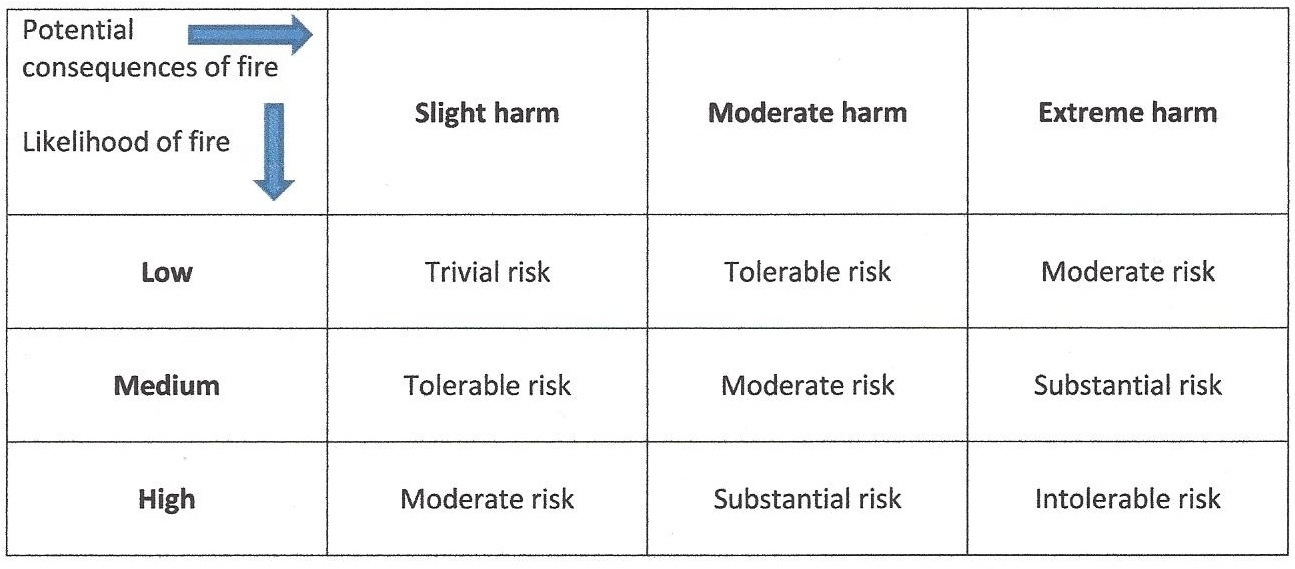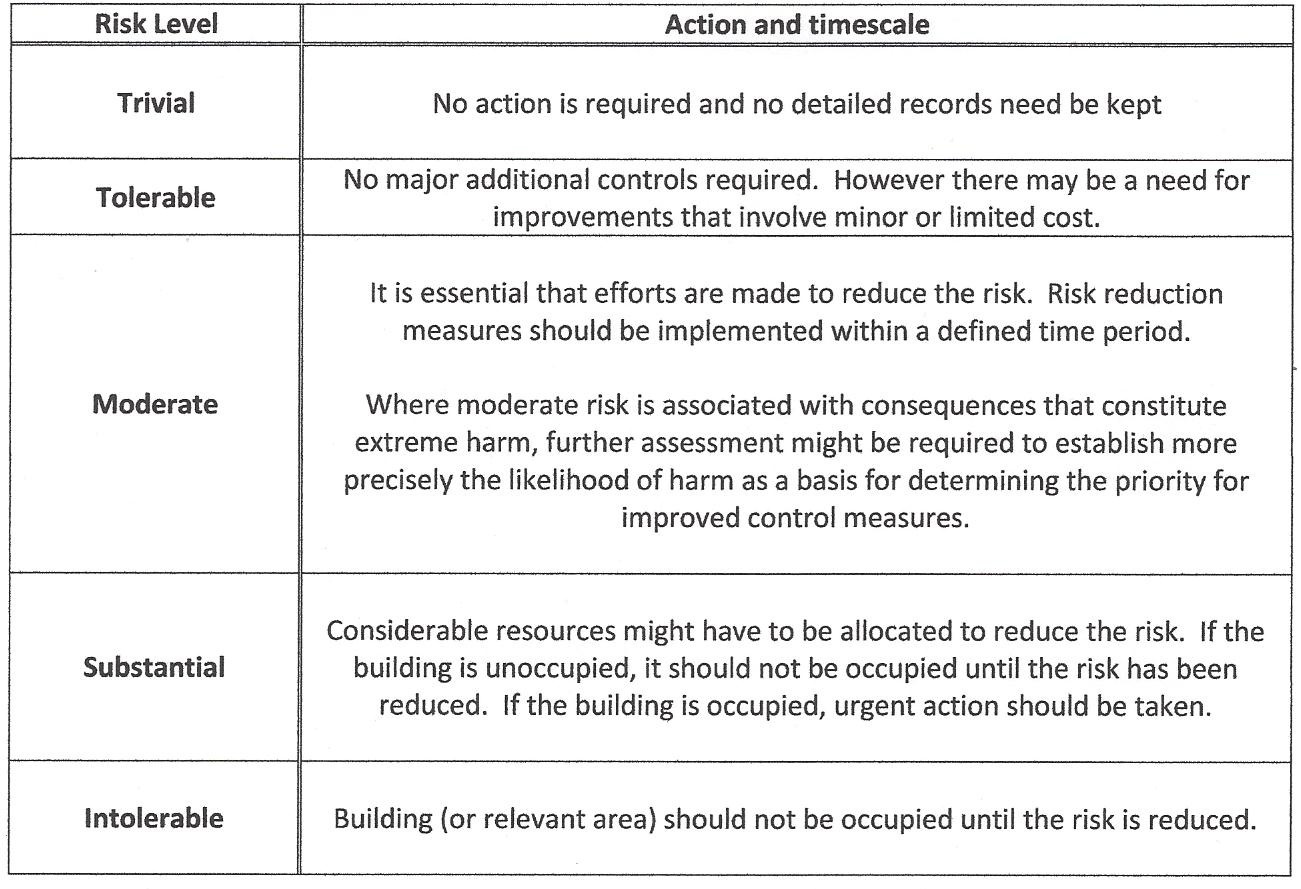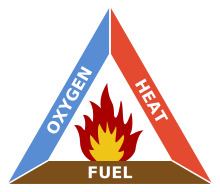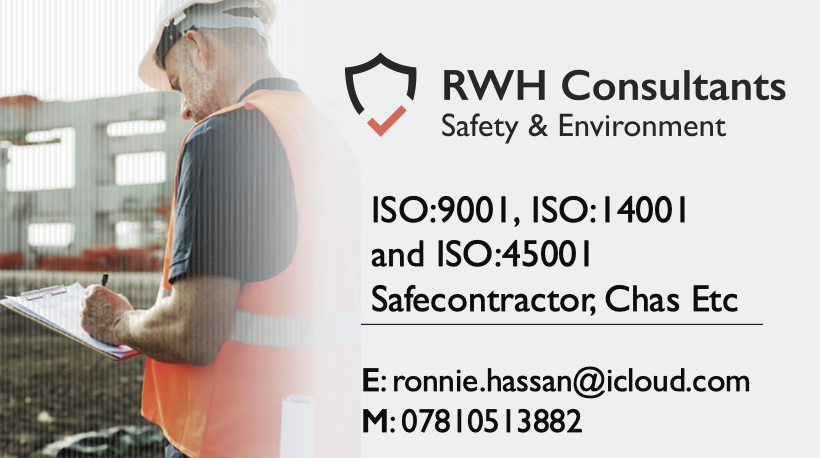Information
-
Document No.
Introduction
-
The purpose of this report is to provide an assessment of the risk to life from fire in these premises, and where appropriate, to make recommendations to ensure compliance with fire safety legislation. This report does not address the risk to property or business continuity from fire.
-
This fire risk assessment should be reviewed by a competent person by the date indicated above or at such earlier times as there is reason to suspect that it is no longer valid, or if there has been a significant change in the matters to which it relates, or if a fire occurs.
-
Employer or Persons having control of the premises: WALKERS SHORTBREAD LIMITED
-
Address of premises
- Aberlour site
- Elgin site
- SB1
- SB2
- BISCUITS
- ELGIN FACTORY 1
- ELGIN FACTORY 2
- DESPATCH
- WAREHOUSE 9&10
- ELGIN WAREHOUSE
- EXPORT
- ABERLOUR HOUSE
-
Persons consulted
-
Assessor
-
Date of fire risk assessment.
-
Date of previous fire risk assessment.
-
Suggested date for review.
GENERAL INFORMATION
1. THE PREMISES
-
1.3 Brief details of construction.
-
1.4 Use of premises.
2. THE OCCUPANTS
3. OCCUPANTS ESPECIALLY AT RISK FROM FIRE
-
3.3 Occupants in remote areas and lone workers.
-
3.5 Others
4. ADDITIONAL INFORMATION
-
4.1 Fire loss experience
-
4.2 Other relevant information
-
4.3 The following fire safety legislation applies to these premises: FIRE (SCOTLAND) ACT 2005, FIRE SAFETY (SCOTLAND) REGULATIONS 2006
-
4.4 The above legislation is enforced by; LOCAL AUTHORITY (FIRE AND RESCUE SERVICE)
-
4.5 Other legislation that makes significant requirements for fire precautions in these premises (other than the Building (Scotland) Regulations 2004)
FIRE HAZARDS AND THEIR ELIMINATION OR CONTROL
5. ELECTRICAL SOURCES OF IGNITION
-
5.1 reasonable measures taken to prevent fires of electrical ignition.
-
More specifically;
-
5.2 Fixed installation periodically inspected and tested.
-
5.3 Portable appliance testing carried out.
-
5.4 Suitable policy regarding the use of personal electrical appliances.
-
5.5 Suitable limitation of trailing leads and adapters.
6. SMOKING
-
6.1 Reasonable measures taken to prevent fires as a result of smoking.
-
More specifically
-
6.2 smoking prohibited in the building
-
6.3 Smoking prohibited in appropriate areas.
-
6.4 Suitable arrangements for those who wish to smoke.
-
6.5 This policy appear to be observed at time of inspection.
7. WILFUL FIRE RAISING
-
7.1 Does basic security against wilful fire raising by outsiders appear reasonable.
-
7.2 Is there an absence of unnecessary fire load in close proximity to the premises or available for ignition by outsiders.
8. PORTABLE HEATERS AND HEATING INSTALLATIONS.
-
8.1 Is the use of portable heaters avoided as far as practicable.
-
If portable heaters used answer 8.1 & 8.2
-
8.1 Is the use of the more hazardous type avoided (e.g. Radiant bar fires or LPG appliances)
-
8.2 Are suitable measures taken to minimise the hazards of ignition of combustible materials.
-
8.3 Are fixed heating installations subject to regular maintenance.
9. Cooking
-
9.1 Are reasonable measures taken to prevent fires as a result of cooking.
-
More specifically
-
9.2 Are filters changed and ductwork cleaned regularly.
-
9.3 Suitable extinguishing appliances available.
10. LIGHTNING
-
10.1 Does the building have a lightning protection system.
11. HOUSEKEEPING
-
11.1 Is the standard of housekeeping adequate.
-
More specifically
-
11.2 Combustible materials appear to be separated from ignition sources.
-
11.3 Avoidance of inappropriate storage of combustible materials or waste.
-
11.4 Appropriate storage of hazardous materials.
-
11.5 Avoidance of inappropriate storage of combustible materials.
12. HAZARDS INTRODUCED BY OUTSIDE CONTRACTORS AND BUILDING WORKS.
-
12.1 Are fire safety conditions imposed on outside contractors.
-
12.2 Is there satisfactory control over works carried out in the building by outside Contractors (including hot work permits)
-
12.3 If there are in-house maintenance personnel, are suitable precautions taken during hot work, including the use of permits
13. DANGEROUS SUBSTANCES
-
13.1 If dangerous substances are or could be used, has a risk assessment been carried out as required by the Dangerous Substances and Explosive Atmosphere Regulations 2002
14. OTHER SIGNIFICANT FIRE HAZARDS THAT WARRANT CONSIDERATION INCLUDING PROCESS HAZARDS THAT IMPACT ON THE FIRE SAFETY MEASURES.
-
14.1 Hazards?
15. MEANS OF ESCAPE FROM FIRE
-
15.1 it is considered that the building is provided with reasonable means of escape in case of fire.
-
More specifically
-
15.2 Adequate design of escape routes.
-
15.3 Adequate provision of exits.
-
15.4 Exits easily and immediately operable where necessary.
-
15.5 Fire exits open on direction of escape where necessary.
-
15.6 Avoidance of sliding or revolving doors as fire exits where necessary.
-
15.7 Satisfactory means for securing exits.
-
Reasonable distances of travel
-
15.8 Where there is a single direction of travel.
-
15.9 Where there are alternative means of escape.
-
15.10 Suitable protection of escape routes.
-
15.11 Suitable fire precautions for all inner rooms.
-
15.12 Escape routes unobstructed.
-
15.13 it is considered that the building is provided with reasonable arrangements for means of escape for disabled people.
16. MEASURES TO LIMIT FIRE SPREAD AND DEVELOPEMENT.
-
It is considered that there is;
-
16.1 Compartmentation of a reasonable standard.
-
16.2 Reasonable limitation of linings that may promote fire spread.
17. EMERGENCY ESCAPE LIGHTING
-
17.1 Reasonable standard of emergency escape lighting system provided.
18. FIRE SAFETY SIGNS AND NOTICES.
-
18.1 Reasonable standard of fire safety signs and notices.
19. MEANS OF GIVING WARNING IN CASE OF FIRE.
-
19.1 Reasonable manually operated electrical fire alarm system provided.
-
19.2 Automatic fire detection provided.
-
19.3 Extent of automatic fire detection generally appropriate for the occupancy and risk. (where fitted)
-
19.4 Remote transmission of alarm signals.
20. MANUAL FIRE EXTINGUISHING APPLIANCES.
-
20.1 Reasonable provision of portable fire extinguishers.
-
20.2 Hose reels provided.
-
20.3 Are all fire extinguishing appliances readily accessible.
21. OTHER RELEVANT FIXED SYSTEMS AND EQUIPMENT.
-
21.1
22. PROCEDURES AND ARRANGEMENTS.
-
22.1 Fire safety is managed by.
-
22.2 Competent person(s) nominated to assist in undertaking the fire safety measures.
-
22.3 Is there a suitable record of the fire safety arrangements.
-
22.4 Appropriate fire procedures in place.
-
More specifically.
-
22.5 Are procedures in the event of fire appropriate and properly documented.
-
22.6 Are there suitable arrangements for summoning the fire and rescue service.
-
22.7 Are there suitable arrangements to meet the fire and rescue service on arrival and provide relevant information, including that relating to hazards to fire fighters.
-
22.8 Are there suitable arrangements for ensuring the premises have been evacuated.
-
22.9 Is there a suitable assembly point.
-
22.10 Are there adequate procedures for evacuation of any disabled people who are likely to be present.
-
22.11 Persons nominated and trained to use fire fighting appliances.
-
22.12 persons nominated and trained to assist with evacuation, including evacuation of disabled people.
-
22.14 Appropriate liaison with fire and rescue service (e.g. By fire and rescue service crews visiting for familiarisation visits).
-
22.15 Routine in-house inspections of fire precautions (e.g. In the course of health and safety inspections).
23. TRAINING AND DRILLS
-
23.1 Are all staff given adequate fire safety instruction and training on induction.
-
23.2 Are all staff given adequate periodic refresher training at suitable intervals.
-
Does staff training provide information, instruction or training on the following;
-
23.3 Fire risks in premises.
-
23.4 The fire safety measures in the building.
-
23.5 Action in the event of fire.
-
23.6 Action on hearing the fire alarm signal.
-
23.7 Method of operation of manual call points.
-
23.8 Location and use of fire extinguishers.
-
23.9 means for summoning the fire and rescue service.
-
23.10 Identity of persons nominated to assist with evacuation.
-
23.11 Identity of persons nominated to use fire fighting appliances.
-
23.12 Are staff with special responsibilities (e.g. fire wardens) given additional training.
-
23.13 Are fire drills carried out at appropriate intervals.
-
23.14 Is their employer given appropriate information (e.g. On fire risks and fire safety measures).
-
23.15 Is it ensured that the employees are provided with adequate instructions and information.<br>
24. TESTING AND MAINTENANCE
-
24.1 Adequate maintenance of premises.
-
24.2 Weekly testing and periodic servicing of fire detection and alarm systems.
-
24.3 Monthly and annual testing routines for emergency escape lighting.
-
24.4 Annual maintenance of fire extinguishing appliances.
-
24.5 Annual testing of fire hydrants.
-
24.6 Weekly testing and periodic inspection of sprinkler installations.
-
24.7 Routine checks of final exit doors and/or security fastenings.
-
24.8 Annual inspection and test of lightening protection systems.
-
24.9 Other relevant inspections or tests.
25. RECORDS
-
Appropriate records of:
-
25.1 Fire drills.
-
25.2 Fire training.
-
25.3 Fire alarm tests.
-
25.4 Emergency escape lighting tests.
-
25.5 Maintenance and testing of fire protection systems.
FIRE RISK ASSESSMENT
-
The following simple risk estimator is based on a more general health and safety risk level estimator of the type contained in BS8800:
-
-
Taking into account the fire prevention measures observed at the time of this risk assessment and the definition of the levels given below, it is considered that the hazard from fire (likelihood of fire) is:<br><br>Low= Unusually low likelihood of fire as a result of negligible potential sources of ignition.<br><br>Medium= Normal fire hazards (e.g. Potential ignition sources) for this type of occupancy, with fire hazards generally subject to proper controls (other than minor shortcomings).<br><br>High= Lack of adequate controls applied to one or more significant hazards, such as to result in significant increase in likelihood of fire.
-
Taking into account the nature of the building and the occupants, as well as the fire protection and procedural arrangements observed at the time of this fire risk assessment, it is considered that the consequences for life safety in the event of fire would be:<br><br>Slight harm= Outbreak of fire unlikely to result in serious injury or death of any occupant (other than an occupant sleeping in a room in which a fire occurs).<br><br>Moderate harm= Outbreak of fire could foresee ably result in injury (including serious injury) of one or more occupants, but it is unlikely to involve multiple fatalities.<br><br>Extreme harm= Significant potential for serious injury or death of one or more occupants.
-
Accordingly, it is considered that the risk to life from fire at these premises is:
-
A suitable risk-based control plan should involve effort and urgency that is proportional to risk. The following risk-based control plan is based on one advocated by BS8800 for general health and safety risks.
-
(Note that, although the purpose of this section is to place the fire risk in context, the above approach to fire risk assessment is subjective and for guidance only. All hazards and deficiencies identified in this report should be addressed by implementing all recommendations contained in the following action plan. The fire risk assessment should be reviewed regularly.
ACTION PLAN
-
Enter category
Action required.
-
Report question number.
-
Action required.
-
Priority.<br>Low - corrective action should be agreed and implementation planned.<br>Medium - corrective action should be agreed and implemented by an agreed deadline<br>High - corrective action should be agreed and implemented without undue delay
-
Person responsible for corrective action.
-
Proposed completion date















